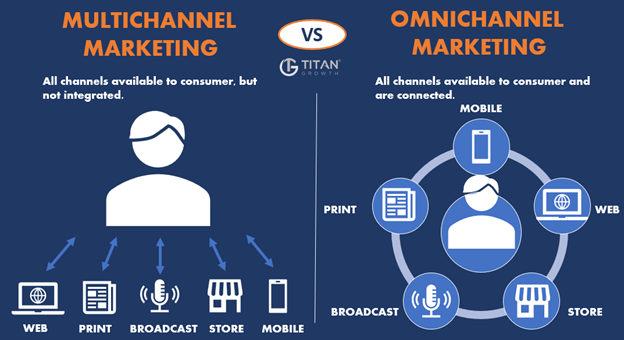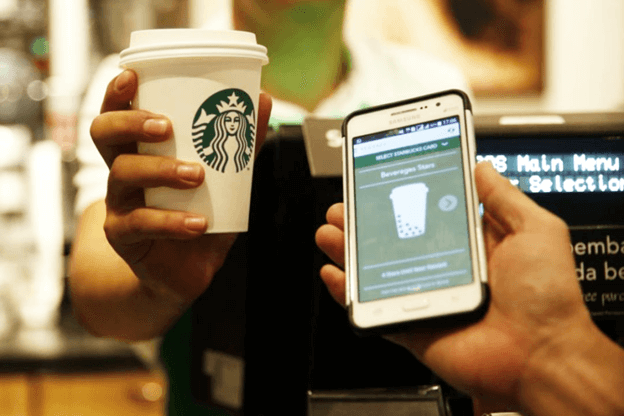Previously we discussed the importance of multichannel marketing, how to do it correctly, and why it’s so much better than watching PBS.
But that was just the first step towards developing an epic omnichannel marketing strategy to grow your business sales. Now we take things to the next level.
In that prior discussion, we concluded multichannel marketing looks like this:

Not too shabby.
But as good as that is, we can do better.
A lot better.
So today, we’re going to turn your marketing strategy from that into this:

That’s right, a cat riding a sloth riding a dinosaur surrounded by pizza, ice cream, donuts, and In-N-Out Burger standing in a celestial realm encircled by a rainbow.
Or as we like to call it: Omnichannel Marketing.
(And yes, to answer your question, you can get that image on a T-Shirt.)
What is Omnichannel Marketing?
Omnichannel marketing breaks down as follows:
- Omni, as in “of all things, ways and places.”
- Channel, as in “a passageway providing access to specific ends or objects.”
- Marketing, as in “that thing you do to promote your business and make lots of money so you can buy more pizza and donuts.”
Put those three things together, and what do we have?
The Holy Trinity of Laser Animals.
Also…
An interconnected content strategy that reaches your target audience across all possible channels and touchpoints to improve customer experience, enhance brand awareness, and drive higher sales.
In other words, omnichannel marketing is a seamless branded experience relevant to the buyer’s journey across every channel.
That’s the gist of it.
Though the concept of sales-driven omnichannel marketing is probably best grasped by comparing it to what it is not.
Omnichannel Marketing vs. Multichannel Marketing
People often confuse “multichannel marketing” with “omnichannel marketing.” These are not the same. And should not be treated as such.
Though to be fair, they do share some very close similarities.
For example, omnichannel and multichannel strategies both focus on using multiple channels to reach customers.
You can see where the confusion might stem.
So it’s probably best to try and not think of them as two individually distinct strategies, but rather an extension of one another. Think of omnichannel marketing as the evolution of multichannel marketing into something more powerful, effective, and awesome.
Just like how this….

Eventually evolved into this…

Another good way to understand the difference between omnichannel and multichannel marketing is to look at their definitions:
- Multichannel marketing is the ability for a brand to communicate with customers on various, separate platforms. These channels include a retail location or a website or an Instagram feed or print ad, etc…
- Omnichannel marketing is the ability for a brand to communicate seamlessly with customers by integrating those various platforms into a singular branded experience.
Here’s that difference visualized:

Omnichannel marketing shifts the way people progress through the sales funnel. Instead of linearly sending them from top to bottom, it puts the customer at the center, allowing them to interact with a brand anytime, anywhere.
Consider these two scenarios:
- Scenario 1: A consumer sees an Instagram post from a brand and “likes” it. Later, that same consumer sees an ad for the brand and visits their website to learn more. A couple of days later, the consumer visits the brand’s retail store and buys a product. Three channels. Three interactions. Three separate results. That’s the end of their relationship.
- Scenario 2: A consumer sees an Instagram Story about a particular product from a brand and clicks it. They are brought to the product page on the brand’s website, where they are prompted to download a mobile app to receive an immediate discount on that product. They do so and are brought to the product page on the app. They use the discount to buy the product on the app, but choose to pick it up in-store to avoid paying for shipping. At the same time, they receive in-app reward points from the purchase that they can use for discounts on future purchases online or in-store. Four channels. Four interactions. One result. Their relationship remains open.
Can you tell which scenario utilizes omnichannel and which uses multichannel?
(Hint: It’s the second scenario.)
In scenario number one, each channel funnels the consumer towards different results that don’t integrate with one another and don’t keep the consumer engaged beyond their respective interactions.
In scenario number two, each channel is seamlessly integrated to funnel the consumer towards one singular result while simultaneously keeping them engaged once that result is completed.
This creates a unified experience.
Three Popular Brands Absolutely Nailing Omnichannel Marketing Right Now
There are few better real-world examples of omnichannel marketing in action than the following three brands.
Disney Parks: Omnichanneling Magical Moments

From its well-designed mobile-responsive website to its interactive My Disney Experience mobile app to its implementation of Magic Bands, Disney seamlessly integrates on every level. And that’s just at its theme parks.
Disney takes the cake when it comes to unifying online and offline marketing channels to create a more engaging branded experience. And when you consider the epic cross-promotion created by its vast number of branded entities, spanning film, TV, retail, and travel, few companies on this planet can match Disney’s omnichannel omnipotence.
Starbucks: A Venti Sized Omnichannel Approach

Starbucks is a leader in omnichannel marketing, thanks in large part to one thing and one thing alone: Loyalty Programs. While it might seem like run-of-the-mill these days for a business to offer a rewards program, there’s a reason for that. Starbucks showed the way.
By enabling customers to earn points, order drinks, design drinks, get discounts, and find deals tailored to their preferences — via phone, app, web, or in-store — Starbucks encourages cross-channel engagement like any good omnichannel strategy should.
Apple: Thinking Omni-Differently

Apple is proof that brick and mortar isn’t dead. In fact, they’ve reinvented it with an omnichannel twist into “click and mortar.”
Apple Stores are all about showcasing the experience of using Apple products. Knowing customers can (and mostly do) shop online, making a sale in-store is less important to them. Instead, they use an offline brand touchpoint to enhance their online sales funnel, tying everything together with consistent branding across every channel.
Okay, so you get it.
Disney, Starbucks, and Apple are slowly taking over the world, thanks to omnichannel marketing.
Big whoop.
Why should you care?
You’re not getting any of that Frozen money.

Well, we can glean a few key things from these three that will help your business omnichannel. And that you should very much care about.
5 Things Required for Your Omnichannel Strategy to Work
Several factors go into implementing a successful omnichannel strategy. Without these, your efforts will fall flat.
No one wants that.
So here are five things to ensure that doesn’t happen. Even better, these seemingly simple principles will help your business grow with a vengeance. All you need to do is apply them to your omnichannel workflow.
1. Remain Customer Focused
Multichannel marketing is sales-driven and channel-focused. It seeks to deliver sales via as many channels as possible. This is a short term approach. Omnichannel marketing, on the other hand, is a longer-term, brand-driven, customer-focused approach. It seeks to build a relationship with customers by inter-relating those channels around a singular brand message. Starbucks’ loyalty program is a perfect example, as is pretty much everything Apple does.
2. Prioritize Consistency Over Conversions
Take it from Disney and Apple, delivering the same brand messaging across all channels does wonders. Apple Stores aren’t designed to drive sales; they are designed as an in-person touchpoint with its brand. Consistency is more profitable for them than someone dropping by to buy a computer and then never returning.
Similarly, ad campaigns built solely around generating one-off conversions can result in jumbled messaging from one campaign to the next and a disjointed customer experience across channels. But focusing all your campaigns around a consistent brand image can be far more effective. Do that, and conversions will follow. (So long as you have a brand that speaks to your audience.)
3. Synergize Your Team
Creating consistency begins and ends with your team. From PR to social media to sales and development, they all need to be on the same page. Departments should have the freedom to innovate individually, but everyone needs to collaborate before engaging the customer on any channel when all is said and done. Need a template? Try Steve Jobs’ Collaborative Framework.
4. Make Engagement Effortless
Omnichannel marketing should foster an effortless buying experience. The Starbucks app makes it super easy to order a drink. Disney’s Magic Bands are a digital swiss-army knife for vacationing. Apple Stores provide full, transparent access (hence the massive glass facades), letting customers effortlessly walk off the street and play with their products. Ask yourself, how can you, too, make your buying experience more effortless for your customers?
5. Put Unity Before Omneity
When starting with an omnichannel approach, don’t try and integrate “all” the marketing channels in existence into your marketing mix, at least not at first.
Instead of trying to streamline your strategy across ALL channels, unify your marketing across the BEST channels for your business. In fact, omnichannel marketing would probably be better referred to as “unichannel marketing.” Alas, the marketing industry didn’t ask our opinion when it was handing out names, so here we are.
What’s the main takeaway from these principles?
There are certainly right and wrong ways to implement omnichannel marketing.
Disney, Starbucks, and Apple are doing it the right way. Keep these principles at the forefront of your approach.
But where should you start?
Start Omnichannel Marketing Through Omnicampaigning
Studies show that businesses implementing omnichannel marketing see customer retention increase by 91% and 287% higher purchase rates.
Despite that, over 50% of companies have no cross-channel strategy in place.
So there’s definitely an opportunity for improvement.

Of those businesses not performing omnichannel marketing, 64% cite a lack of resources and investments as the biggest barrier. That’s fair. But not a reason not to try.
In fact, the evolution into omnichannel marketing can have a minimal to no cost impact when done right. But to make the transition easier and smoother, for any budget, we suggest a smaller-scale approach to first get a taste of the benefits omnichannel marketing can provide.
That means starting simply with something we like to call “omni-campaigning.”
What’s omni-campaigning?
It takes the broader key principles that we shared for omnichannel marketing above and applies them at a smaller campaign level.
Take a product. Any product.
You’re promoting it on several different channels, right? Say organic search, a Facebook ad, email, and Amazon. Each of those channels requires you to create a campaign. An organic campaign. A Facebook ad campaign. An email campaign. An Amazon campaign. All are promoting the same product, just through multiple channels.
But instead of building each of those campaigns separately, one-at-a-time, you create them all at the same time, with similar messaging that ties into one another. The result is one extensive campaign relying on multiple channels.
That’s omni-campaigning.
Same budget. Same resources. Same number of channels. Different approach.
It’s a soft entry into building an omnichannel business.
There’s a good chance you’re already doing something similar to this. If you add a dose of branding to all your marketing, you are already dipping your toes into omnichannel marketing.
From there, expand that branding using additional marketing channels to create singularly focused campaigns around the brand. And this even includes Amazon, where users typically have less control over ad creative but can more than makeup for it by building their brand story with A+ Content and ALO.
Track results. Adjust accordingly. And scale upwards as your profit margins increase.
It’s a systematic omni-approach that can work for every brand.
You don’t need to build a glassy retail store full of geniuses, design an immersive app that conjures coffee, or buy Lucasfilms to succeed in omnichannel marketing. You can start small and simply by seamlessly integrating your current different campaigns into one.
Test it out.
You might be surprised to find that it only takes a slight realignment to go from a good multichannel marketing approach to an awesome omnichannel marketing strategy.

And shoot rainbow lasers from your eyes.
Unsure if shooting rainbow lasers from your eyes is a good thing?
Yes, it is.


